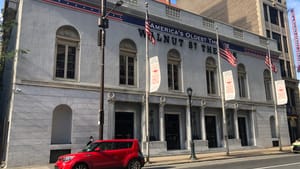Stay in the Loop
BSR publishes on a weekly schedule, with an email newsletter every Wednesday and Thursday morning. There’s no paywall, and subscribing is always free.
Staging history
As artists continue to rally against the Walnut, it’s time to ask: who is “America’s Oldest Theatre”?

Why do activists in today’s Philly theater community think they can change the Walnut Street Theatre, an institution operating since 1808? The answer is that they can’t. But not because 213 years is too much history to challenge. It’s because the Walnut Street Theatre Company, which we usually refer to as if it’s centuries old, is not, in fact, as historic as it sounds.
The company itself does nothing to dispel this confusion. Look at its “History” webpage. It says “The Walnut Street Theatre, founded in 1808, is America’s Oldest Theatre. It is also the Official State Theatre of Pennsylvania, and a National Historic Landmark.” The company’s website header reads “America’s Oldest – Founded 1808.”
This is true, at least in part—if you’re talking about the building itself. But people who want to learn more about the Walnut Street Theatre Company could not be blamed for thinking, at a glance, that the same theater company producing BEEHIVE – the ‘60s Musical this September has been operating since the early 19th century.
The Walnut timeline
The Walnut does offer “History of the Theatre” and “Theatre Timeline” pages, where we learn that a venue called The New Circus opened on the Walnut site in 1808, presenting equestrian acts. In 1811, architect William Strickland updated the venue (redubbed The Olympic) with a stage and pit for theatrical performances. The next year, The Rivals became the venue’s first-ever stage production.
The site didn’t become permanently known as the Walnut Street Theatre until 1828, when architect John Haviland renovated its interior and exterior. Throughout the 19th and 20th centuries, the theater had many owners and boasted many notable moments in American theater history. Architect William H. Lee rebuilt the interior in 1920, and the site became a National Historic Landmark in 1964.
A 2010 University of Pennsylvania historic preservation thesis titled “Preserving the Neighborhood Theatres of William Harold Lee” by Mark Edward Donofrio offers an interesting account of the theater’s tumultuous history from the mid-1960s to the early 1980s.
The Walnut Street Theatre Corporation was born in the late 1960s as a community nonprofit, but by 1969 the site faced demolition for a planned parking lot. The Walnut Street Theatre Corporation rallied and was able to buy and renovate the building with money from Hass Community Funds (today’s William Penn Foundation). Architect F. Bryan Loving tore out Lee’s 1920 rebuild for a modern interior and an exterior that recreated Haviland’s 1828 design.
But the theater suffered over the next several years—producers couldn’t afford the high rents, and the theater once more teetered on ruin. Its board removed the executive director in 1976 because of the deficits, and did not hire a new one until 1982, when an international search tapped Bernard Havard, who launched the Walnut Street Theatre Company in 1983. Havard and managing director Mark Sylvester of the Walnut Street Theatre Company are the main targets of the new activist coalition Protect the Artist (PTA), who are protesting what they claim are abusive employment practices there.
“The opposite of preservation”?
Does the Walnut building really have the historic status that the current nonprofit claims? Penn scholar Donofrio argues that the stage doesn’t deserve the popular moniker “America’s Oldest Theatre.” He says the Haas-funded Loving renovation that opened in 1971 made a hodgepodge of the site’s long history.
Assuming that the 1828 Haviland renovation was the most historically and architecturally significant, the Loving renovation took that as a guide for the current Walnut exterior. The Haviland exterior design was well-documented, despite the fact that it had mostly disappeared over the following century. However, the latest architectural team didn’t have documentation of Haviland’s interior. Loving demolished the ornate 1920 interior (designed by Lee) in favor of a modern one with a Greek Revival feel.
“Such a re-creation was the opposite of preservation,” Donofrio writes. He compares it to “gutting and stripping down a historic building, restoring its original appearance with different materials, installing a modern interior, and then calling the building historic.”
Writing in 2010, Donofrio asserts that the “Walnut Street Theatre is technically a 40-year-old structure.”
“America’s oldest playhouse”
A 38-year-old theater company housed in a 51-year-old structure is a different story than the one we see promoted by the Walnut as well as the press. That matters, especially when you’re reporting on activists for social justice taking their message to a supposedly historic institution.
A Philly Mag interview with PTA leader Jenna Pinchbeck incorrectly calls the Walnut “America’s oldest continuously operating theater company.” WHYY’s reporting on the same events says “Walnut Street Theatre is the oldest continuously operated theater in America” and that “Havard has been at the helm for 39 years.” This elides the fact that Havard founded the current company, and that the company is the protestors’ target, not the building. A recent Inquirer op-ed (harping on the Walnut’s lawyer’s grammar, of all things) says that “America’s oldest playhouse sent a cease-and-desist letter,” when in reality, Havard sent a cease-and-desist letter on behalf of his 38-year-old company.
Who’s in the building?
A glance at other regionals reminds us that we don’t conflate the building with the company in other cases: Philadelphia Theatre Company performs at the Suzanne Roberts Theatre; the Lantern performs at St. Stephens. The Wilma predates its current eponymous Avenue of the Arts venue by more than 20 years. No one confuses Arden Theatre Company with the Walnut, even though it launched at the Walnut before it built its own home in 1995.
Unlike its fellow theater companies, who don’t define themselves by the buildings they own or occupy, it behooves the Walnut Street Theatre Company to blur the line between its building and its productions. Its branding tells ticket-buyers that they’re participating in valuable programming simply because the theater building itself is historic. And this narrative likewise may benefit the company in the current controversy, implicitly casting PTA activists as a flash-in-the-pan rabble while the company wields its cachet as a prestigious and historic entity.
A truly historic move
Local artists are speaking up about the Walnut Street Theatre Company, and that’s the story we have a responsibility to put in its proper context. If we don’t, we afford the current Walnut leaders a tacit respect that the protest leaders may not receive—when in reality, the institution in question is not much older than a lot of the protestors.
When we’re clear about that fact, instead of characterizing the company as if it’s been around since James Madison was president, maybe it’s easier to hear these artists’ stories, and envision positive change—which would truly honor the Walnut’s place in American theater history.
Sign up for our newsletter
All of the week's new articles, all in one place. Sign up for the free weekly BSR newsletters, and don't miss a conversation.

 Alaina Johns
Alaina Johns